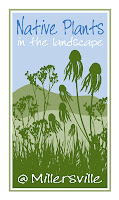Native plants: gardening without guilt
 This is the first year I've come away from the Native Plants in the Landscape conference without feeling I am a total outsider, possibly even a spy, in a nest of native purists. (Just got back from the conference, held June 5 through 7 at Millersville University in Pennsylvania.) The native plant rattle in the American gardening community can be so extreme I hadn't realized before there are many, like me, who occupy a middle ground, even among conference attendees.
This is the first year I've come away from the Native Plants in the Landscape conference without feeling I am a total outsider, possibly even a spy, in a nest of native purists. (Just got back from the conference, held June 5 through 7 at Millersville University in Pennsylvania.) The native plant rattle in the American gardening community can be so extreme I hadn't realized before there are many, like me, who occupy a middle ground, even among conference attendees.C. Colston Burrell's opening presentation on the 20th Century Native Plant Movement in America was a refreshing, highly entertaining, and appropriately generalist take on this sometimes politically charged subject. Yes, native plants are important to maintaining local and regional ecosystems. No, we don't have to plant only natives so long as we are responsible and don't use species proven to be highly invasive and disruptive to the environment. Yes, aesthetics is a valid concern in gardening. After all, humans are part of the ecosystem too; we get to have a say. Yes, it's hard to define "native." But, no, the arrival of white Europeans on American shores isn't a good basis for a valid definition. Regional differences in plants, even plants of the same species, and local genetic provenance, are much more important.
This conference attracts numerous professional garden designers, experienced gardeners, and nursery men and women specializing in native plants, so the level of discourse tends to be quite high. I hope to report on one or two of the more specialized sessions I attended in another posting. I particularly enjoyed Don Knezick's "Genetic Integrity of Native Plants: Provenance is Forever" and Dr. Roger Tai Koide's "Mycorrhizal Fungi: Hidden Friends of Plants."
A highlight of this conference is the native plant sale, and it's one of the best. Nurseries from eastern Pennsylvania down into the Virginias offer perennials, shrubs and trees, many of which are rare in trade and difficult to find. I came back with four winterberry hollies (Ilex verticillata) - nothing rare in that selection but needed in my garden nevertheless, five Iris versicolor of sufficient size to divide into ten plants to join my late May/early June iris splash, two sizeable copper irises (Iris fulva) to go by the pond, two "Dolls eyes" baneberries (Actaea pachypoda) for the woodland garden, one Sagittaria latifolia to go into the pond, and ten Meehania cordata to try out as groundcover in the woodland. Okay, I confess, there's nothing particularly rare in my selections, but other offerings included Moosewood (Acer pennsylvanicum), various native gingers (formerly asarum, now hexastylis), all sorts of big leaf magnolias, Jeffersonia diphylla, and on and on.
If you live within driving distance of Millersville, consider the conference in 2009.
James Golden